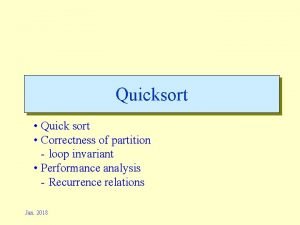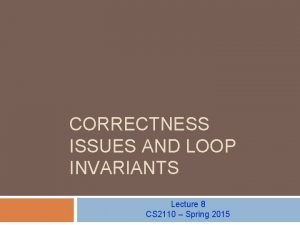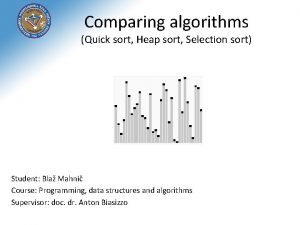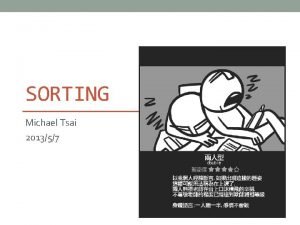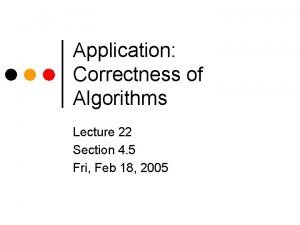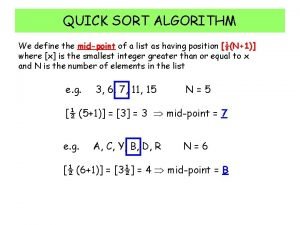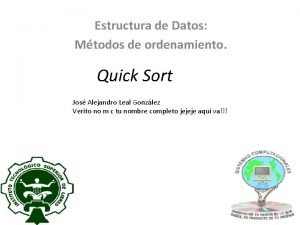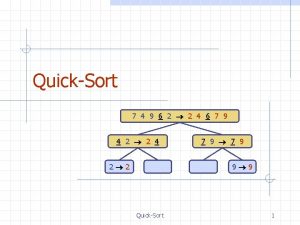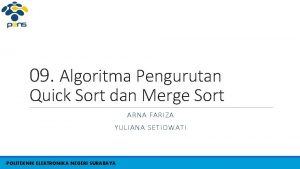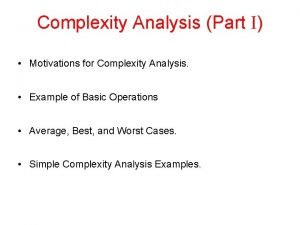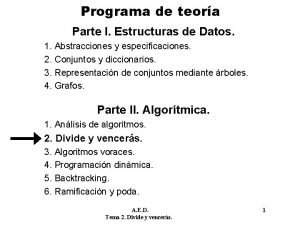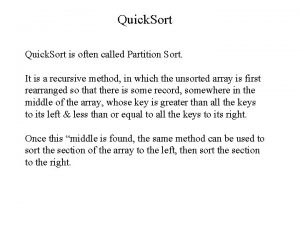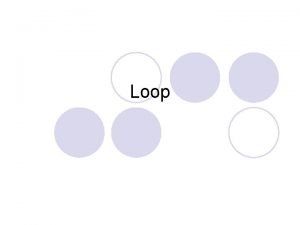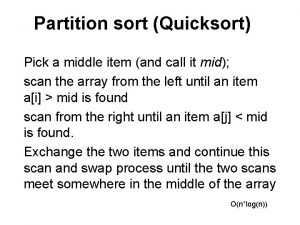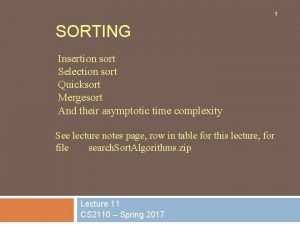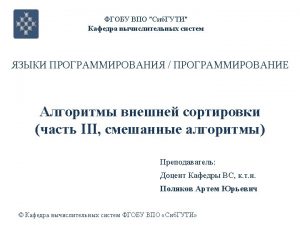Quicksort Quick sort Correctness of partition loop invariant



![Pseudocode Partition(A, p, r) x, i : = A[r], p – 1; for j Pseudocode Partition(A, p, r) x, i : = A[r], p – 1; for j](https://slidetodoc.com/presentation_image_h/14d82ed5ab36e50e1dde3520516b2643/image-4.jpg)


![Partitioning w w Select the last element A[r] in the subarray A[p. . r] Partitioning w w Select the last element A[r] in the subarray A[p. . r]](https://slidetodoc.com/presentation_image_h/14d82ed5ab36e50e1dde3520516b2643/image-7.jpg)

![Correctness of Partition Case 1: A[j] > x i p x r >x x Correctness of Partition Case 1: A[j] > x i p x r >x x](https://slidetodoc.com/presentation_image_h/14d82ed5ab36e50e1dde3520516b2643/image-9.jpg)
![Correctness of Partition w Case 2: A[j] x » A[r] is unaltered. » Increment Correctness of Partition w Case 2: A[j] x » A[r] is unaltered. » Increment](https://slidetodoc.com/presentation_image_h/14d82ed5ab36e50e1dde3520516b2643/image-10.jpg)



















- Slides: 29

Quicksort • Quick sort • Correctness of partition - loop invariant • Performance analysis - Recurrence relations Jan. 2018

Performance w A triumph of analysis by C. A. R. Hoare w Worst-case execution time – (n 2). w Average-case execution time – (nlg n). » How do the above compare with the complexities of other sorting algorithms? w Empirical and analytical studies show that quicksort can be expected to be twice as fast as its competitors. qsort - 2

Design w Follows the divide-and-conquer paradigm. w Divide: Partition (separate) the array A[p. . r] into two (possibly empty) subarrays A[p. . q– 1] and A[q+1. . r]. » Each element in A[p. . q– 1] A[q]. » A[q] each element in A[q+1. . r]. » Index q is computed as part of the partitioning procedure. w Conquer: Sort the two subarrays by recursive calls to quicksort. w Combine: The subarrays are sorted in place – no work is needed to combine them. w How do the divide and combine steps of quicksort compare with those of merge sort? qsort - 3
![Pseudocode PartitionA p r x i Ar p 1 for j Pseudocode Partition(A, p, r) x, i : = A[r], p – 1; for j](https://slidetodoc.com/presentation_image_h/14d82ed5ab36e50e1dde3520516b2643/image-4.jpg)
Pseudocode Partition(A, p, r) x, i : = A[r], p – 1; for j : = p to r – 1 do if A[j] x then i : = i + 1; A[i] A[j] fi od; A[i + 1] A[r]; return i + 1 Quicksort(A, p, r) if p < r then q : = Partition(A, p, r); Quicksort(A, p, q – 1); Quicksort(A, q + 1, r) fi A[p. . r] 5 i j A[p. . q – 1] A[q+1. . r] Partition 5 5 qsort - 4 5

Example initially: next iteration: p r 2 5 8 3 9 4 1 7 10 6 i j next iteration: 2 5 3 8 9 4 1 7 10 6 i j qsort - 5 note: pivot (x) = 6 Partition(A, p, r) x, i : = A[r], p – 1; for j : = p to r – 1 do if A[j] x then i : = i + 1; A[i] A[j] fi od; A[i + 1] A[r]; return i + 1

Example (Continued) next iteration: 2 5 3 8 9 4 1 7 10 6 i j next iteration: 2 5 3 4 9 8 1 7 10 6 i j next iteration: 2 5 3 4 1 8 9 7 10 6 i j after final swap: 2 5 3 4 1 6 9 7 10 8 i j qsort - 6 Partition(A, p, r) x, i : = A[r], p – 1; for j : = p to r – 1 do if A[j] x then i : = i + 1; A[i] A[j] fi od; A[i + 1] A[r]; return i + 1
![Partitioning w w Select the last element Ar in the subarray Ap r Partitioning w w Select the last element A[r] in the subarray A[p. . r]](https://slidetodoc.com/presentation_image_h/14d82ed5ab36e50e1dde3520516b2643/image-7.jpg)
Partitioning w w Select the last element A[r] in the subarray A[p. . r] as the pivot – the element around which to partition. As the procedure executes, the array is partitioned into four (possibly empty) regions. 1. 2. 3. 4. w qsort - 7 A[p. . i] — All entries in this region are pivot. A[i+1. . j – 1] — All entries in this region are > pivot. A[j. . r – 1] — Not known how they compare to pivot. A[r] = pivot. The above hold before each iteration of the for loop, and constitute a loop invariant. (4 is not part of the LI. )

Correctness of Partition w Use loop invariant. w Initialization: » Before first iteration w qsort - 8 • A[p. . i] and A[i+1. . j – 1] are empty – Conds. 1 and 2 are satisfied (trivially). • r is the index of the pivot – Cond. 3 is satisfied. Partition(A, p, r) • Cond. 4 trivially holds. x, i : = A[r], p – 1; Maintenance: for j : = p to r – 1 do if A[j] x then » Case 1: A[j] > x i : = i + 1; • Increment j only. A[i] A[j] • LI is maintained. fi od; A[i + 1] A[r]; return i + 1
![Correctness of Partition Case 1 Aj x i p x r x x Correctness of Partition Case 1: A[j] > x i p x r >x x](https://slidetodoc.com/presentation_image_h/14d82ed5ab36e50e1dde3520516b2643/image-9.jpg)
Correctness of Partition Case 1: A[j] > x i p x r >x x >x j i p j r x x qsort - 9 >x
![Correctness of Partition w Case 2 Aj x Ar is unaltered Increment Correctness of Partition w Case 2: A[j] x » A[r] is unaltered. » Increment](https://slidetodoc.com/presentation_image_h/14d82ed5ab36e50e1dde3520516b2643/image-10.jpg)
Correctness of Partition w Case 2: A[j] x » A[r] is unaltered. » Increment i » Swap A[i] and A[j] • Condition 3 is maintained. • Condition 1 is maintained. » Increment j • Condition 2 is maintained. i p x x x >x i p r j j r x x qsort - 10 >x

Correctness of Partition w Termination: » When the loop terminates, j = r, so all elements in A are partitioned into one of the three cases: • A[p. . i] pivot • A[i+1. . r – 1] > pivot • A[r] = pivot w The last two lines swap A[i+1] and A[r]. » Pivot moves from the end of the array to between the two subarrays. » Thus, procedure partition correctly performs the divide step. qsort - 11

Complexity of Partition w Partition. Time(n) is given by the number of iterations in the for loop. w (n) : n = r – p + 1. Partition(A, p, r) x, i : = A[r], p – 1; for j : = p to r – 1 do if A[j] x then i : = i + 1; A[i] A[j] fi od; A[i + 1] A[r]; return i + 1 qsort - 12

Algorithm Performance Running time of quicksort depends on whether the partitioning is balanced or not. w Worst-Case Partitioning (Unbalanced Partitions): » Occurs when every call to partition results in the most unbalanced partition. » Partition is most unbalanced when • Subproblem 1 is of size n – 1, and subproblem 2 is of size 0 or vice versa. • pivot every element in A[p. . r – 1] or pivot < every element in A[p. . r – 1]. » Every call to partition is most unbalanced when • Array A[1. . n] is sorted or reverse sorted! qsort - 13

Worst-case Partition Analysis Recursion tree for worst-case partition n n– 1 n– 2 n n– 3 2 1 qsort - 14 Running time for worst-case partitions at each recursive level: T(n) = T(n – 1) + T(0) + Partition. Time(n) = T(n – 1) + (n) = k=1 to n (k) = ( k=1 to n k ) = (n 2)

Best-case Partitioning w Size of each subproblem n/2. » One of the subproblems is of size n/2 » The other is of size n/2 1. w Recurrence for running time » T(n) 2 T(n/2) + Partition. Time(n) = 2 T(n/2) + (n) w T(n) = (n lg n) qsort - 15

Recursion Tree for Best-case Partition cn cn/2 cn lg n cn/4 c cn/4 cn c cn : O(n lg n) Total qsort - 16

Recurrences – II Jan. 2018

Recurrence Relations w Equation or an inequality that characterizes a function by its values on smaller inputs. w Solution Methods (Chapter 4) » Substitution Method. » Recursion-tree Method. » Master Method. w Recurrence relations arise when we analyze the running time of iterative or recursive algorithms. » Ex: Divide and Conquer. T(n) = (1) T(n) = a T(n/b) + D(n) + C(n) qsort - 18 if n c otherwise

Technicalities w We can (almost always) ignore floors and ceilings. w Exact vs. Asymptotic functions. » In algorithm analysis, both the recurrence and its solution are expressed using asymptotic notation. » Ex: Recurrence with exact function T(n) = 1 if n = 1 T(n) = 2 T(n/2) + n if n > 1 Solution: T(n) = n lgn + n • Recurrence with asymptotics (BEWARE!) T(n) = (1) if n = 1 T(n) = 2 T(n/2) + (n) if n > 1 Solution: T(n) = (n lgn) w “With asymptotics” means we are being sloppy about the exact base case and non-recursive time – still convert to exact, though! qsort - 19

Substitution Method w Guess the form of the solution, then use mathematical induction to show it correct. » Substitute guessed answer for the function when the inductive hypothesis is applied to smaller values – hence, the name. w Works well when the solution is easy to guess. w No general way to guess the correct solution. qsort - 20

Example – Exact Function Recurrence: T(n) = 1 T(n) = 2 T(n/2) + n s. Guess: T(n) = n lgn + n. s. Induction: if n = 1 if n > 1 • Basis: n = 1 n lgn + n = 1 = T(n). • Hypothesis: T(k) = k lgk + k for all k < n. • Inductive Step: T(n) = 2 T(n/2) + n = 2 ((n/2)lg(n/2) + (n/2)) + n = n (lg(n/2)) + 2 n = n lgn – n + 2 n = n lgn + n qsort - 21

Example – With Asymptotics To Solve: T(n) = 3 T( n/3 ) + n w Guess: T(n) = O(n lg n) w Need to prove: T(n) cn lg n, for some c > 0. w Hypothesis: T(k) ck lg k, for all k < n. w Calculate: T(n) 3 c n/3 lg n/3 + n c n lg (n/3) + n = c n lg n – c n lg 3 + n = c n lg n – n (c lg 3 – 1) c n lg n (The last step is true for c 1 / lg 3. ) qsort - 22

Example – With Asymptotics To Solve: T(n) = 3 T( n/3 ) + n w To show T(n) = (n lg n), must show both upper and lower bounds, i. e. , T(n) = O(n lg n) AND T(n) = (n lg n) w (Can you find the mistake in this derivation? ) w Show: T(n) = (n lg n) w Calculate: T(n) 3 c n/3 lg n/3 + n c n lg (n/3) + n = c n lg n – c n lg 3 + n = c n lg n – n (c lg 3 – 1) c n lg n (The last step is true for c 1 / lg 3. ) qsort - 23

Example – With Asymptotics If T(n) = 3 T( n/3 ) + O (n), as opposed to T(n) = 3 T( n/3 ) + n, then rewrite T(n) 3 T( n/3 ) + cn, c > 0. w To show T(n) = O(n lg n), use second constant d, different from c. w Calculate: T(n) 3 d n/3 lg n/3 +c n d n lg (n/3) + cn = d n lg n – d n lg 3 + cn = d n lg n – n (d lg 3 – c) d n lg n (The last step is true for d c / lg 3. ) It is OK for d to depend on c. qsort - 24

Making a Good Guess w If a recurrence is similar to one seen before, then guess a similar solution. » T(n) = 3 T( n/3 + 5) + n (Similar to T(n) = 3 T( n/3 ) + n) • When n is large, the difference between n/3 and (n/3 + 5) is insignificant. • Hence, can guess O(n lg n). w Method 2: Prove loose upper and lower bounds on the recurrence and then reduce the range of uncertainty. » E. g. , start with T(n) = (n) & T(n) = O(n 2). » Then lower the upper bound and raise the lower bound. qsort - 25

Subtleties w When the math doesn’t quite work out in the induction, strengthen the guess by subtracting a lower-order term. Example: » Initial guess: T(n) = O(n) for T(n) = 3 T( n/3 )+ 4 » Results in: T(n) 3 c n/3 + 4 = c n + 4 » Strengthen the guess to: T(n) c n – b, where b 0. • What does it mean to strengthen? • Though counterintuitive, it works. Why? T(n) 3(c n/3 – b)+4 c n – 3 b + 4 = c n – b – (2 b – 4) Therefore, T(n) c n – b, if 2 b – 4 0 or if b 2. (Don’t forget to check the base case: here c>b+1. ) qsort - 26

Changing Variables w Use algebraic manipulation to turn an unknown recurrence into one similar to what you have seen before. » Example: T(n) = 2 T(n 1/2) + lg n » Rename m = lg n and we have T(2 m) = 2 T(2 m/2) + m » Set S(m) = T(2 m) and we have S(m) = 2 S(m/2) + m S(m) = O(m lg m) » Changing back from S(m) to T(n), we have T(n) = T(2 m) = S(m) = O(m lg m) = O(lg n lg lg n) qsort - 27

Avoiding Pitfalls w Be careful not to misuse asymptotic notation. For example: » We can falsely prove T(n) = O(n) by guessing T(n) cn for T(n) = 2 T( n/2 ) + n T(n) 2 c n/2 + n cn+n = O(n) Wrong! » We are supposed to prove that T(n) c n for all n>N, according to the definition of O(n). w Remember: prove the exact form of inductive hypothesis. qsort - 28

Exercises w Solution of T(n) = T( n/2 ) + n is O(n) w Solution of T(n) = 2 T( n/2 + 17) + n is O(n lg n) w Solve T(n) = 2 T(n/2) + 1 w Solve T(n) = 2 T(n 1/2) + 1 by making a change of variables. Don’t worry about whether values are integral. qsort - 29
 Loop invariant quicksort
Loop invariant quicksort Correctness and the loop invariant
Correctness and the loop invariant Knuth's interval sequence formula
Knuth's interval sequence formula Merge sort loop invariant
Merge sort loop invariant Loop invariant of merge sort
Loop invariant of merge sort Bubble sort invariant
Bubble sort invariant Loop invariant of bubble sort
Loop invariant of bubble sort Bubble sort loop invariant
Bubble sort loop invariant Quick sort merge sort
Quick sort merge sort Quick sort vs selection sort
Quick sort vs selection sort Quick sort merge sort
Quick sort merge sort Quicksort vs merge sort
Quicksort vs merge sort Loop invariant code motion
Loop invariant code motion Loop invariant c++
Loop invariant c++ Binary search invariant
Binary search invariant Loop variant
Loop variant Quick find algorithm
Quick find algorithm Quickchek menu
Quickchek menu Quick sort algorithm
Quick sort algorithm Quick sort
Quick sort How to do quick sort
How to do quick sort Quick sort
Quick sort Quick sort on linked list
Quick sort on linked list Quick sort iterative
Quick sort iterative Quick sort
Quick sort Is quick sort in place
Is quick sort in place Quick sort algorithm with example
Quick sort algorithm with example Quick sort algoritma
Quick sort algoritma Quick sort worst complexity
Quick sort worst complexity Quick sort
Quick sort
